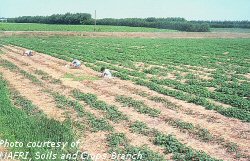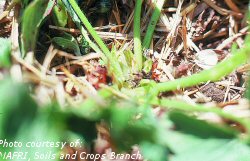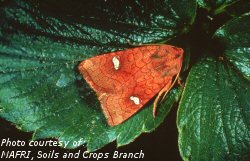Strawberry Cutworm

Strawberry cutworm damage to field

Early signs of cutworm damage - clipped stems

Mature cutworm larva

Adult strawberry cutworm
Host Plants And Distribution
The strawberry cutworm is native to Canada and is an important pest of strawberry plantings. Other species of cutworms are widely distributed throughout North America and may cause damage sporadically.
Biology
Female strawberry cutworm moths mate and lay their eggs in July on dead strawberry leaves. These eggs survive through the winter and larvae hatch from the eggs in early May. The young larvae first feed on fruit stalks and leaf stems, sometimes clipping stems. Later, they bore into the crown, killing the plant. Feeding goes on from late May to mid-July. Outbreaks are sporadic but can be devastating.
Symptoms And Damage
Symptoms include leaf feeding, severed plant stems and wilting plants. Damage is similar to that caused by winter kill and may be mistaken. Ensure that cutworms are present before applying control measures. Damage is often worse in older plantings where populations of cutworms have had time to build up.
Scouting Techniques
Infestations may be located by looking for damaged patches of plants. Cutworms are nocturnal and prefer to hide during the day. Inspection of the litter and soil immediately near a damaged plant may reveal the presence of larvae. Older fields are more likely to be infested.
Economic Thresholds
Thresholds have not been established for this insect. If control measures have been applied recently, it is unlikely that they will be needed again in the same field. Cutworm populations build up slowly. Spot treatment is often all that is required to knock back an infestation.

